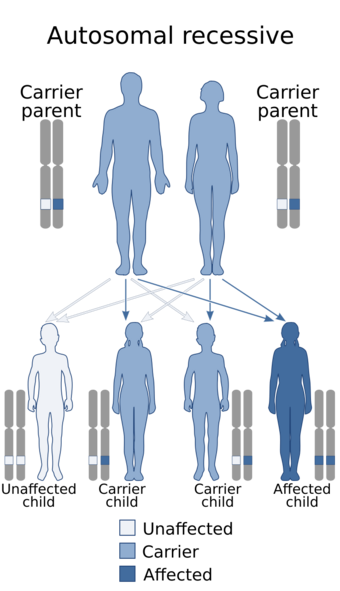Medicine:Mismatch repair cancer syndrome
| Mismatch repair cancer syndrome | |
|---|---|
| Other names | Brain tumor-polyposis syndrome, Glioma-polyposis syndrome |
 | |
| This condition is inherited in an autosomal recessive manner | |
| Specialty | Oncology |
Mismatch repair cancer syndrome (MMRCS) is a cancer syndrome associated with biallelic DNA mismatch repair mutations.[1] It is also known as Turcot syndrome (after Jacques Turcot, who described the condition in 1959) and by several other names.[1]
In MMRCS, neoplasia typically occurs in both the gut and the central nervous system (CNS).[1] In the large intestine, multiple colonic polyps develop; in the CNS, brain tumors.
Genetics
Under the name constitutional mismatch repair-deficiency, (CMMR-D), it has been mapped to MLH1, MSH2, MSH6 or PMS2.[2] Monoallelic mutations of these genes are observed in the condition known as Lynch syndrome or hereditary nonpolyposis colorectal cancer, while biallelic mutations are observed in CMMR-D.[3] People expressing the HNPCC (which itself is considered autosomal dominant) trait are considered carriers of CMMR-D, thus CMMR-D is classified as autosomal recessive.[citation needed]
The term "childhood cancer syndrome" has also been proposed.[4][5] Café-au-lait macules have been observed.[6]
Diagnosis
Childhood to early adult onset HNPCC + malignant gliomas. The polyps developed tend to be larger, fewer, and progress to malignancy earlier than those seen in familial adenomatous polyposis,[1] a clinically similar condition with different underlying mutations. Diagnostic testing consists of a blood sample being collected, and a genetic specialist compares two copies of a patient's gene to normal MMR genes. If there are differences in the genes, the specialists are able to further test and decide if the patient has the deficiency. [7]
Treatment
History
OMIM currently includes "Turcot syndrome" under Mismatch repair cancer syndrome. Turcot syndrome is the association between familial polyposis of the colon and brain tumors[8] like medulloblastoma, malignant glioma. It was first reported by Canadian surgeon Jacques Turcot (1914-1977 ) et al. in 1959 and hence carries the first author's name.[9]
See also
- Gardner syndrome
References
- ↑ 1.0 1.1 1.2 1.3 Online Mendelian Inheritance in Man (OMIM) 276300
- ↑ "Rhabdomyosarcoma in patients with constitutional mismatch-repair-deficiency syndrome". Journal of Medical Genetics 46 (6): 418–20. June 2009. doi:10.1136/jmg.2008.064212. PMID 19293170. https://hal.archives-ouvertes.fr/hal-00552674/file/PEER_stage2_10.1136%252Fjmg.2008.064212.pdf.
- ↑ "Constitutional mismatch repair-deficiency syndrome: have we so far seen only the tip of an iceberg?". Human Genetics 124 (2): 105–22. September 2008. doi:10.1007/s00439-008-0542-4. PMID 18709565.
- ↑ "Homozygous PMS2 germline mutations in two families with early-onset haematological malignancy, brain tumours, HNPCC-associated tumours, and signs of neurofibromatosis type 1". European Journal of Human Genetics 16 (1): 62–72. January 2008. doi:10.1038/sj.ejhg.5201923. PMID 17851451.
- ↑ "Biallelic PMS2 mutations and a distinctive childhood cancer syndrome". Journal of Pediatric Hematology/Oncology 30 (3): 254–7. March 2008. doi:10.1097/MPH.0b013e318161aa20. PMID 18376293.
- ↑ "Café-au-lait macules and pediatric malignancy caused by biallelic mutations in the DNA mismatch repair (MMR) gene PMS2". Pediatric Blood & Cancer 50 (6): 1268–70. June 2008. doi:10.1002/pbc.21514. PMID 18273873.
- ↑ "Constitutional Mismatch Repair Deficiency Syndrome" (in en). https://www.stjude.org/disease/constitutional-mismatch-repair-deficiency.html.
- ↑ "Turcot syndrome" at Dorland's Medical Dictionary
- ↑ "Malignant tumors of the central nervous system associated with familial polyposis of the colon: report of two cases". Diseases of the Colon and Rectum 2: 465–8. 1959. doi:10.1007/bf02616938. PMID 13839882.
External links
| Classification | |
|---|---|
| External resources |
 |

